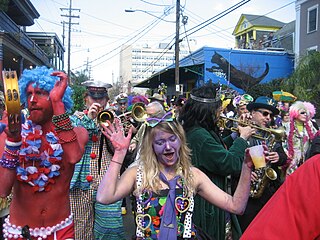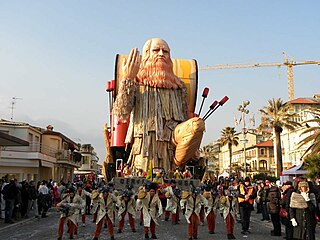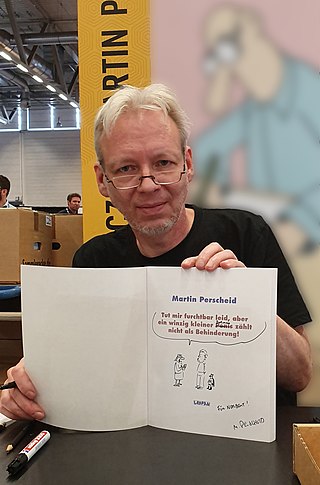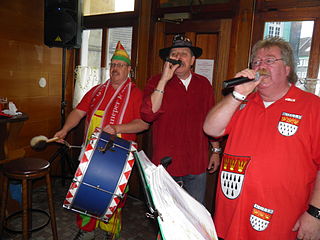
Mardi Gras is the final day of Carnival or Shrovetide before Ash Wednesday. Mardi Gras is French for "Fat Tuesday", reflecting the practice of the last night of consuming rich, fatty foods in preparation for the fasting season of Lent.

Carnival or Shrovetide is a Christian festive season that occurs before Lent, consisting of Quinquagesima or Shrove Sunday, Shrove Monday, and Shrove Tuesday or Mardi Gras.

Düsseldorf is the capital city of North Rhine-Westphalia, the most populous state of Germany. It is the second-largest city in the state after Cologne, and the seventh-largest city in Germany, with a population of 653,253.

The holiday of Mardi Gras is celebrated in southern Louisiana, including the city of New Orleans. Celebrations are concentrated for about two weeks before and through Shrove Tuesday, the day before Ash Wednesday. Mardi Gras is French for Fat Tuesday, the season is known as Carnival and begins on 12th Night, January 6th, and extends until midnight before Ash Wednesday. Club, or Krewe, balls start soon after, though most are extremely private, with their Kings and Queens coming from wealthy old families and their courts consisting of the season's debutantes. Most of the high society Krewes do not stage parades. As Fat Tuesday gets nearer, the parades start in earnest. Usually there is one major parade each day ; many days have several large parades. The largest and most elaborate parades take place the last five days of the Mardi Gras season. In the final week, many events occur throughout New Orleans and surrounding communities, including parades and balls.

Bad Godesberg is a borough of Bonn, southern North Rhine-Westphalia, Germany. From 1949 to 1999, while Bonn was the capital of the Federal Republic of Germany, most foreign embassies were in Bad Godesberg. Some buildings are still used as branch offices or consulates.

Christopher Street Day (CSD) is an annual European LGBTQ+ celebration and demonstration held in various cities across Europe for the rights of LGBTQ+ people, and against discrimination and exclusion. It is Germany's and Switzerland's counterpart to Gay Pride or Pride Parades. Austria calls their Pride Parade Rainbow Parade. The most prominent CSD events are Berlin Pride, CSD Hamburg, CSD Cologne, Germany and Zürich in Switzerland.

Shrove Monday is part of the Carnival or Shrovetide celebrations of the week before Lent, following Quinquagesima or Shrove Sunday and preceding Shrove Tuesday or Mardi Gras.

The Cologne Carnival is a carnival that takes place every year in Cologne, Germany.

Rosenmontag is the highlight of the German Karneval (carnival), and takes place on the Shrove Monday before Ash Wednesday, the beginning of Lent. Mardi Gras, though celebrated on Fat Tuesday, is a similar event. Rosenmontag is celebrated in German-speaking countries, including Germany, Austria, Switzerland and Belgium, but most heavily in the carnival strongholds which include the Rhineland, especially in Cologne, Bonn, Düsseldorf, Aachen and Mainz. In contrast to Germany, in Austria, the highlight of the carnival is not Rosenmontag, but Shrove Tuesday.

The Carnival of Viareggio is a Carnival event annually held in the Tuscan city of Viareggio, in Italy. It is considered amongst the most renowned Carnival celebrations in both Italy and Europe.

Martin Perscheid was a German cartoonist. He created a main character in 1994, who appeared from 1998 under the title Perscheids Abgründe. More than 4,300 strips appeared in several German newspapers and magazines. He is known for his "fearless glimpses into human abysses of sexism, racism, ignorance, corruption and stupidity, captured with black humour."

The Rijeka Carnival is held each year before Lent in Rijeka, Croatia. Established in 1982, it has become the biggest carnival in Croatia.

The Mainz Carnival is a months-long citywide carnival celebration in Mainz, Germany that traditionally begins on 11 November but culminates in the days before Ash Wednesday in the spring.

A variety of customs and traditions are associated with Carnival celebrations in the German-speaking countries of Germany, Switzerland and Austria. They can vary considerably from country to country, but also from one small region to another. This is reflected in the various names given to these festivities occurring before Lent.
This article outlines the COVID-19 pandemic in the German federal state of North Rhine-Westphalia. As of April, there have been 19,384 confirmed cases, including 446 deaths.
Rivalry between Cologne and Düsseldorf, two major cities in the Rhineland, Germany, 40 kilometres (25 mi) apart on the Rhine, is now mostly on a sporting and cultural level, but based on historical and economic factors. Cologne was a Roman colony, and later a Free Imperial City, while Düsseldorf, a small medieval settlement, is now the capital of the state of North Rhine-Westphalia.

The Malkasten-Redoute was an annual masquerade ball for the Düsseldorf carnival period organized at the Malkasten in Düsseldorf.
The Düsseldorfer Karneval is the Düsseldorf variant of the "fifth season" known as carnival. The Düsseldorf carnival begins on 11 November each year with the symbolic awakening of the Hoppeditz and ends on Ash Wednesday of the following year with his burial. The period of carnival is called the Carnival session and marks a high point in the social life of the state capital with numerous sittings and balls. Together with the events in Cologne and Mainz, the carnival procession is one of the largest in Germany. Its annual television broadcast made it known nationwide.

A carnival society is a German association of carnival enthusiasts who organize and celebrate events related to carnival. In Cologne, a distinction is made between committee and corps societies as well as the "Veedelsvereine".

The Master Drone, also known as God Emperor Trump, was a 65-foot (20-meter) papier-mâché sculpture and float depicting Donald Trump, the president of the United States at the time, dressed as the fictional God Emperor of Mankind from the Warhammer 40,000 franchise. It was created by the Italian artist Fabrizio Galli for the Carnival of Viareggio in 2019.


















